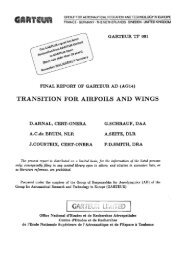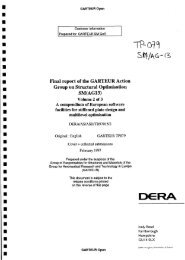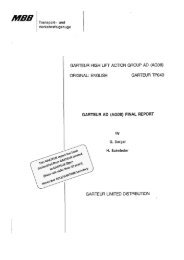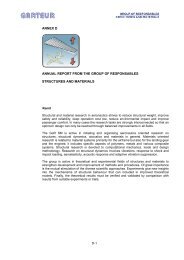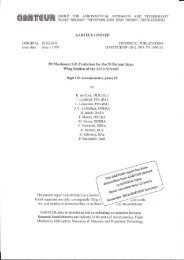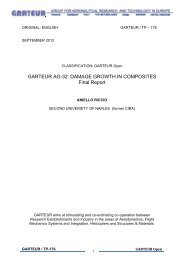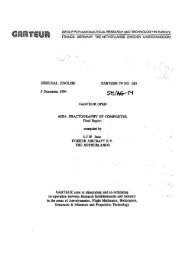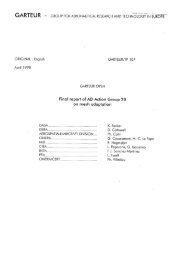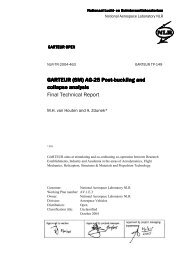Cadmium Substitution - garteur
Cadmium Substitution - garteur
Cadmium Substitution - garteur
You also want an ePaper? Increase the reach of your titles
YUMPU automatically turns print PDFs into web optimized ePapers that Google loves.
GARTEUR LIMITED<br />
compared with cadmium plating. Specimens with a configuration shown in figure F1 were<br />
stress corrosion tested to ASTM G44-75. In this test, the specimens were subjected to<br />
alternate immersion in 3.5% sodium chloride solution. One cycle in this standard<br />
includes 10 minutes in salt solution and fifty minutes drying in air. The total exposure<br />
time was 30 days.<br />
The notched tensile strength was determined on three specimens. Values of 2700, 2705<br />
and 2690 M Pa were achieved. For one set of stress corrosion specimens the notch was<br />
covered to 180 o by an aluminium casing. The reason for using this casing is to initiate<br />
galvanic corrosion and crevice corrosion. The specimens were then loaded to and held<br />
at 75% of the notched tensile strength. Each treatment was represented by three<br />
individual specimens The treatments tested were:-<br />
F.3 Results and discussion<br />
• Reference without protective coating<br />
• Porous cadmium plating<br />
• Zinc-nickel plating<br />
• Zinc-cobalt-iron plating<br />
• Sermetel<br />
• Electrodeposited aluminium<br />
• Delta-tone<br />
F.3.1<br />
Susceptibility to hydrogen embrittlement<br />
The results of slow bend tests conducted on a 35 NCD 16 steel (1800 MPa) are<br />
presented in figure F1. The results indicate that for the SermeTel coatings, there is<br />
minimal embrittlement due to plating. In the case of the electrodeposited aluminium<br />
some reduction is observed but this may be recovered by heat treating at 190 o C.<br />
One of the three electroplated zinc-nickel notched tensile specimens tested, failed within<br />
the 200 hours test period. In the second series of specimens tested, no failures occurred<br />
and it is considered that the electrodeposited zinc-nickel coating is non-embrittling.<br />
F.3.2<br />
Susceptibility to stress corrosion cracking<br />
In the sustained load tests, two specimens of three of those protected with zinc-cobaltiron<br />
and those protected with Delta-tone coating in the test set using the aluminium<br />
casings, failed within two days. Sacrificial coatings may add to the risk of post plating<br />
embrittlement. SAAB uses ZnCoFe plating to 1250 M Pa, a strength level considered to<br />
be safe. The specimens used in this investigation were hardened to 1400 M Pa.<br />
In the second test set, where no casing was used , two specimens of three with Deltatone<br />
coating failed within two days. All other specimens remained unbroken after 30<br />
days.<br />
Previous research undertaken by SAAB [F2] compared the performance of IVD<br />
aluminium and electrodeposited cadmum coatings applied to notched tensile specimens<br />
machined from either a 1366 Ni-Cr-Mo steel or a 1745 precipitation hardening stainless<br />
steel. As in the current research programme, the specimens were loaded to 75% of the<br />
notched tensile strength. From the tests undertaken, there was no indication that<br />
aluminium-coated specimens have a higher tendency to delayed fracture in a corrosive<br />
environment than cadmium coated ones.<br />
F.4 Conclusions<br />
Page 86<br />
GARTEUR SM/AG17 TP128




